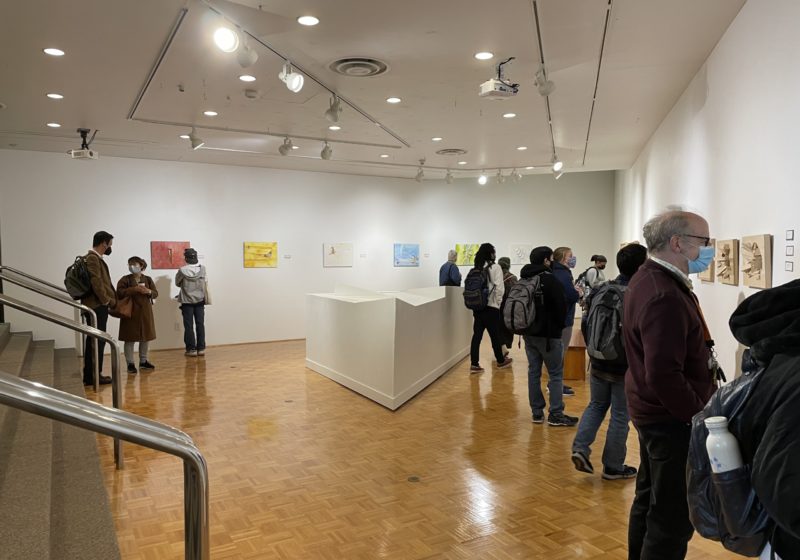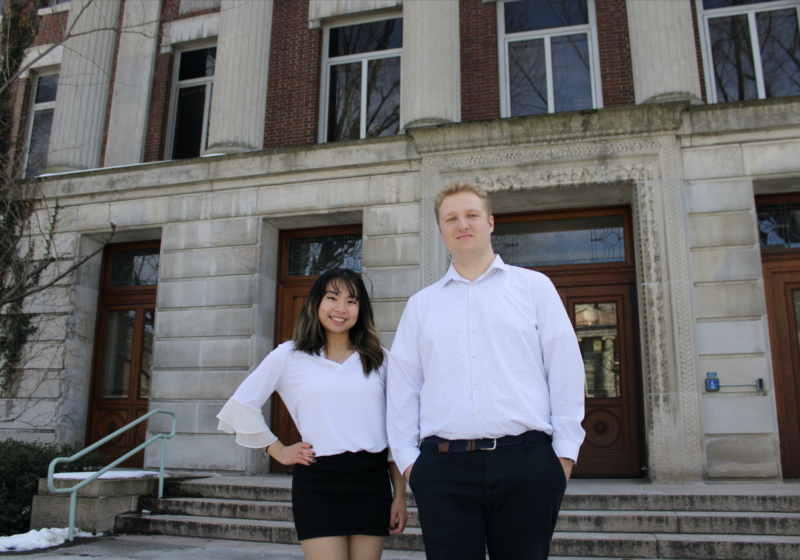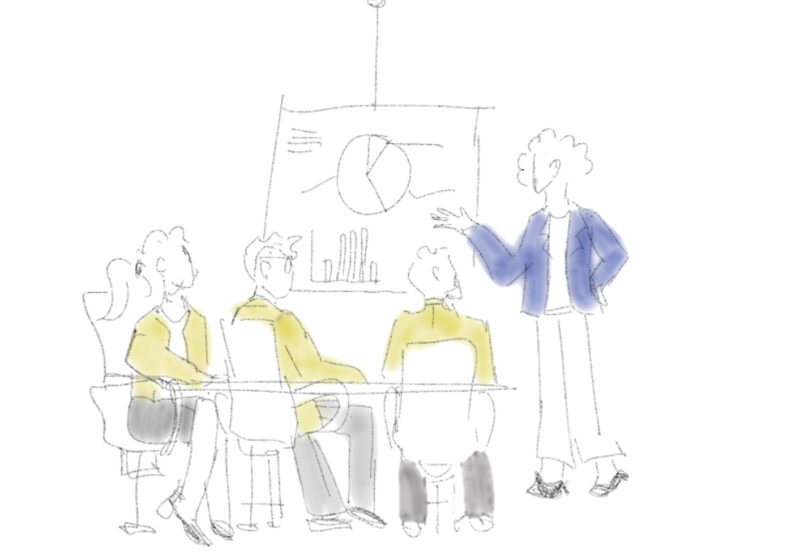An architect, a painter, and a sculptor all walk into Hartnett Gallery. One wonders how they consolidated their individual skills, only to discover that they are all the same person: Chicago-based artist, Brian Petrone.
Petrone’s new exhibit, “Sites and Non-Sites,” is Hartnett Gallery’s first professional artist show this semester and features a multimodal fusion that takes on an almost timeless quality. It superimposes maps on top of paintings, wood on top of canvas, and the past on top of the present. The exhibit opened last Thursday after a brief talk in Morey Hall with Petrone, faculty, and students.
The collection is titled after the writings of prominent land artist Robert Smithson, which define “non-site” as a metaphorical representation of a physical place (or “site”) that is relocated to a museum or gallery. Petrone explained at the talk how his work employs skills and techniques usually specific to architecture, painting, and sculpting, respectively. He also talked about how his time at architecture firms helped him learn to bend the once-limiting rules of architecture; in “forming mass, sculpting space, and manipulating light,” he’s discovered how to let seemingly different disciplines shape and inform each other. In the process, he has gained an agency that allows him to create freely.
Of the pieces on display, Petrone’s — and my — personal favorite is “Urban Experiment 01,” which depicts his fascination with the idea that cities are like living organisms, constantly growing and evolving. The piece, which to me is reminiscent of Taylor Swift’s pop anthem “Welcome to New York” (“like any great love, it keeps you guessing / like any real love, it’s ever-changing”), is constructed of chipboard and basswood. Expanding over a flat surface like an uninhibited crystalline growth engineered in a lab, it somehow looks both like a city and an organic entity under a microscope.
While this and other works line the walls, if you walk into Hartnett Gallery this month, the first thing you’ll see is the massive white structure in the middle of the room. Petrone opened his talk by introducing the audience to this installation: a model of the glacier that once stretched over Rochester. Walking the audience through the history of the land, he discussed its evolution from a particularly attractive hunting trail to the city we know (and perhaps even love), and how the pressure that this two-mile thick ice sheet exerted has shaped the landscape over the millennia.
This site-specific installation represents how “the natural rhythms of the earth, although slow and sometimes not obvious, impact how we live today,” according to Petrone. His interest in the relationship between the natural forces that mold the land and the lives of its inhabitants is also closely connected to his passion for climate action. Petrone thinks that the climate crisis is “something we must face up to,” for which artists have a uniquely powerful platform to raise awareness. Thus, the glacier, which might look lofty but relatively nondescript at first glance, in fact represents what we stand to lose in the face of global warming.
Petrone cited the earth art movement of the ’60s and ’70s as a major influence on his work. The movement focused on exploring our relationship with the environment, rejecting the commodification of art, and reconnecting with the artistic drive behind ancient structures such as the European and African henges and the Nazca Lines in Peru. Among many other great works, Petrone mentioned Alan Sonfist’s “Time Landscape” — an “oasis” of a pre-colonial forest in the middle of New York City — as another example of earth art that has the potential to redefine how we think about our relationship with the planet.
While Petrone aspires to someday create environmental sculptures of a similar scale, his public sculpture for Dubuque, Iowa’s “Art on the River” program comes pretty close. Titled “Resiliency Flows,” the installation contains about 12 thousand bamboo poles of varying heights to create a scale model of the Mississippi. Petrone said he wanted the sculpture to symbolize the importance of individual actions that might lead to “greater consequences down the stream.” If viewed from an ecological perspective, the installation can be interpreted as a commentary on the negative impacts that actions upstream might have downstream in vulnerable river systems. However, for the artist, the work also represents a lesson that he feels we must learn from the pandemic: the importance of collective action for the greater good.
Petrone’s work, which is rooted in the present but is inextricably connected to what once was, expands Sonfist’s thesis to not only memorialize the past but be in a constant conversation with it. “Sites and Non-Sites” encourages audiences to rethink the way we perceive and interact with the land we live on and off of, and thus pay closer attention to its growth, death, and rebirth. Petrone’s figurative excavation of specific sites to uncover their history and create art is almost archaeological, and speaks to the pressure art can exert on the (physical and abstract) spaces it exists in.
“Brian Petrone: Sites and Non-Sites” is on display in the Hartnett Gallery until Oct. 23.






